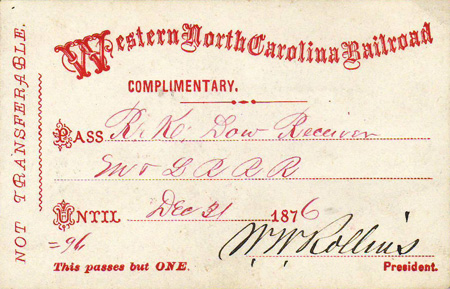Before the North Carolina Railroad was completed in 1856, a crop failure in the west prompted citizens to push for a railroad to connect the eastern and central counties with Asheville. In response, the legislature agreed to build two important extensions of the North Carolina Railroad-the Atlantic & North Carolina Railroad from Goldsboro to Beaufort and the Western North Carolina Railroad from Salisbury to Morganton. The route from Goldsboro to Beaufort was finished in 1858, but work on the Salisbury-to-Morganton track was very slow and costly.

After the Civil War, which virtually halted construction, the state in 1866 subscribed $4 million to the Western North Carolina Railroad to continue the project. John A. Hunt finished the rest of Charles F. Fisher's work east of Morganton, and plans were made for completion of the next section from Morganton to Old Fort. With no ready cash on hand, the railroad's president and stockholders were eager for governmental aid. The state constitutional convention of 1868 and the Republican State Convention authorized the issuance of bonds totaling $6.4 million to extend the road from Morganton to Asheville. In the same year George W. Swepson and Gen. Milton S. Littlefield secured absolute control of the Western North Carolina Railroad by purchasing 2,000 of the 3,080 bonds issued.
The railroad then became a victim of Swepson and Littlefield's corruption. During the administration of Governor William W. Holden, the two men issued worthless securities, participated in fraudulent stock subscriptions, and built a huge debt. The road was pillaged, Littlefield and his cronies fled the state, and Holden was impeached.
After the so-called Littlefield scandal, the state bought the Western North Carolina Railroad for $665,000 in 1870. The same year the Democratic-controlled legislature cut off financial support to the railroads and leased the Western North Carolina to other companies such as the Richmond & Danville Railroad. Construction of the Western North Carolina Railroad stopped in Murphy in 1891 before an extension to Ducktown, Tenn., could be completed. In 1894 the railroad was reorganized as the Southern Railway Company.